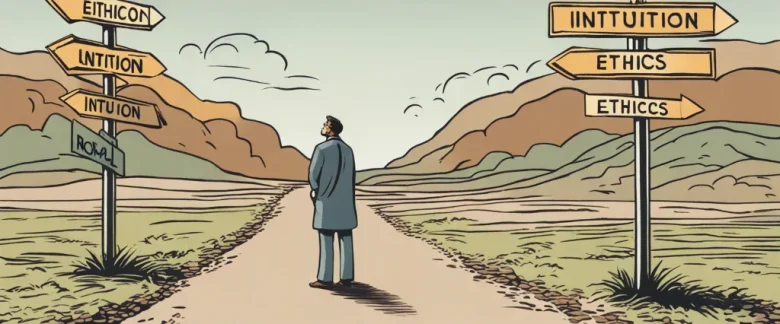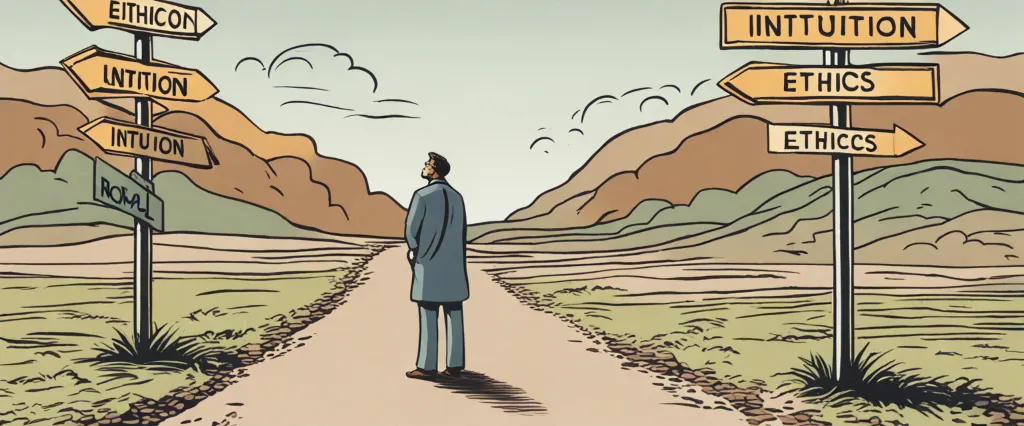In “Ethics for the Real World,” renowned scholar Ronald A. Howard embarks on a captivating exploration of ethical decision-making in our complex modern society. With an extensive background in both philosophy and engineering, Howard brings a unique perspective to the table, blending analytical rigor with practical insights. By dismantling traditional notions of morality, he delves into the intricacies of ethical dilemmas and provides readers with a valuable toolkit to navigate the ambiguous terrain of real-world ethics. In this summary, we will examine Howard’s thought-provoking concepts and paradigm-shifting ideas, equipping ourselves with a fresh vision for ethical reasoning in the 21st century.
Chapter 1: The Foundations of Ethics
Chapter 1: The Foundations of Ethics provides an introductory overview of the field of ethics and lays the groundwork for understanding the practical implications of ethical decision-making. In Ethics for the Real World, Ronald A. Howard emphasizes that ethical thinking is essential for navigating the complexities of everyday life and making responsible choices.
The chapter begins by debunking common misconceptions about ethics, such as the belief that it is merely a matter of personal preference or opinion. Howard highlights the objective nature of ethics, asserting that ethical principles are not arbitrary but are based on rational arguments and universal values that promote human well-being.
Next, Howard introduces the concept of ethical principles, focusing on three key principles: utility, rights, and justice. He explains that the principle of utility is concerned with maximizing overall happiness or well-being for the greatest number of individuals. The rights principle emphasizes the protection of individual liberties and interests, while the justice principle emphasizes fairness and impartiality.
Howard also discusses the importance of ethical dilemmas, which arise when there are conflicting principles or values at stake. He presents several illustrative examples to demonstrate how ethical dilemmas can arise in various aspects of life, such as business, personal relationships, and social issues.
Towards the end of the chapter, Howard explores the role of ethics in decision-making, emphasizing the importance of examining the consequences, rights, and justice aspects of a situation. He introduces the Ethical Decision-Making Framework (EDMF), which outlines a structured approach to resolving ethical dilemmas.
In summary, Chapter 1 serves as an introduction to the field of ethics and establishes the foundations necessary for understanding ethical decision-making. It emphasizes the objective nature of ethics, introduces key ethical principles, explores ethical dilemmas, and provides a framework for ethically evaluating and resolving complex situations.
Chapter 2: Ethical Decision Making
Chapter 2 of “Ethics for the Real World” by Ronald A. Howard focuses on ethical decision making and provides a practical framework for individuals and organizations to make ethical choices in their daily lives and work.
The chapter begins by acknowledging that ethical decision making is a complex process affected by personal values, culture, and the desire to balance numerous competing interests. Howard emphasizes that ethical decision making requires conscious effort and a willingness to critically evaluate the potential consequences of our actions.
The author introduces a 5-step decision-making process for ethical dilemmas: framing the ethical issue, gathering relevant facts, identifying stakeholders, evaluating alternatives, and making a well-grounded decision. Each step is discussed in detail, providing illustrative examples and practical advice.
To effectively frame the ethical issue, Howard suggests identifying the important values involved, as well as any relevant ethical principles or guidelines. Gathering relevant facts involves understanding the situation and considering both immediate and long-term consequences of potential actions.
Identifying stakeholders involves recognizing all the individuals or groups that will be affected by the decision. Evaluating alternatives requires considering both the positive and negative consequences of each potential course of action, and determining which option aligns best with ethical principles. Finally, making a well-grounded decision involves considering various perspectives, reflecting on personal values, and being able to explain and support the chosen course of action.
Howard emphasizes the importance of proactively thinking about the ethical dimension of decisions before they are made, rather than reacting to ethical dilemmas as they arise. By following this decision-making process, individuals and organizations can navigate complex ethical challenges and make choices that align with their values and principles.
Chapter 3: Ethical Responsibility
Chapter 3 of “Ethics for the Real World” by Ronald A. Howard focuses on the concept of ethical responsibility. The chapter delves into understanding the responsibilities individuals and organizations hold when making ethical decisions, both in their personal lives and within a professional context.
The author emphasizes that understanding one’s ethical responsibilities is crucial because it helps guide our actions and decision-making process. He begins by discussing the external sources of ethical responsibility, such as legal and social obligations. For example, laws may dictate how we should behave in certain situations, and societal norms may further shape our ethical responsibilities.
However, Howard emphasizes that ethical responsibilities extend beyond these external guidelines and are also influenced by an individual’s personal values and principles. He highlights the importance of aligning personal ethics with professional ethics and organizational values when making decisions in a workplace setting.
The chapter also explores the moral responsibility that comes with being part of an organization. Howard emphasizes that organizations have a duty to provide an ethical framework for their employees and must foster a culture that promotes ethical behavior. By doing so, organizations can create an environment where employees feel empowered and supported to make ethical decisions.
Furthermore, the author examines how ethical responsibility can be divided within an organization and clarifies individual and collective responsibilities. He introduces the concept of ethical trade-offs, explaining that individuals and organizations must navigate complex scenarios where multiple ethical responsibilities may conflict.
Overall, Chapter 3 of “Ethics for the Real World” emphasizes the importance of understanding one’s ethical responsibilities and the role they play in decision-making, both personally and professionally. It emphasizes the need for individuals and organizations to align their actions with their values and contribute to fostering an ethical environment.
Chapter 4: Ethical Leadership

Chapter 4 of “Ethics for the Real World” by Ronald A. Howard focuses on the concept of ethical leadership and its importance in today’s complex world. The chapter begins by presenting several real-life examples that illustrate the consequences of unethical leadership, including the Enron scandal and the financial crisis of 2008. These examples serve as a reminder that ethical leadership is crucial not only for the success of organizations but also for the well-being of society as a whole.
The author then delves into the qualities and behaviors that define ethical leaders. According to Howard, ethical leaders prioritize fairness, transparency, and accountability. They are committed to acting in the best interest of all stakeholders and value ethical principles over personal gain. Additionally, ethical leaders foster a culture of integrity within their organizations, encouraging their employees to make ethical decisions and holding them accountable when they fall short.
The chapter also explores some common challenges faced by ethical leaders, such as the pressure to prioritize short-term profits over long-term sustainability, the need to navigate conflicting stakeholder interests, and the difficulty of upholding ethics in a competitive environment. Howard offers strategies for overcoming these challenges, including the development of a strong moral compass, cultivating a diverse and inclusive team, and aligning organizational incentives with ethical behavior.
At the end of the chapter, the author emphasizes the importance of ethical leadership at all levels of an organization, stating that leaders at every level have the power to shape the ethical climate and culture. By exhibiting ethical leadership, individuals can work towards building organizations that prioritize integrity, fairness, and long-term success.
Chapter 5: Ethical Communication
Chapter 5: Ethical Communication of the book Ethics for the Real World by Ronald A. Howard explores the importance of effective and ethical communication in our personal and professional lives. The chapter highlights the challenges individuals face when trying to communicate ethically and provides guidance on how to navigate these challenges.
The chapter begins by emphasizing the significance of ethical communication in building trusted relationships. It highlights that ethical communication requires clear and open dialogue, ensuring that both parties fully understand each other’s perspective. Howard emphasizes that understanding others’ beliefs and values is essential for resolving conflicts and reaching mutually beneficial solutions.
The chapter further examines the potential pitfalls in communication, such as distortion, secrecy, deception, and manipulation. Distortion refers to the unintentional miscommunication that occurs when people fail to articulate themselves clearly. Secrecy, on the other hand, refers to the conscious act of withholding information, which can harm relationships and trust. Deception and manipulation, often seen as ethically questionable communication strategies, undermine honesty and transparency.
To foster ethical communication, the author introduces the concept of “Advocacy and Inquiry” as an effective communication approach. Advocacy involves expressing one’s thoughts and perspectives, while inquiry focuses on understanding the other person’s thoughts and perspectives. By combining both, individuals can engage in honest and meaningful dialogue, building mutual respect and understanding.
The chapter also addresses challenges in ethical communication due to power dynamics and societal pressures. It encourages individuals to be aware of their own biases and privileges, actively seeking to mitigate their influence on communication dynamics.
In conclusion, Chapter 5 of Ethics for the Real World emphasizes the importance of ethical communication for building trust and resolving conflicts. It provides practical guidelines, such as the Advocacy and Inquiry approach, to navigate the challenges and enhance the quality of our interactions.
Chapter 6: Ethical Teams
Chapter 6 of the book “Ethics for the Real World” by Ronald A. Howard focuses on ethical teams. The chapter explores the importance of teamwork in fostering an ethical culture within organizations.
The chapter begins by pointing out that teams play a crucial role in decision-making, problem-solving, and implementing actions. However, ethical considerations are often neglected in team discussions, and decisions are often driven solely by the pursuit of immediate goals. The author emphasizes that ethical teams should prioritize the long-term impact of their decisions on stakeholders, rather than simply focusing on short-term gains.
To build ethical teams, Howard suggests three key steps. The first step is to ensure that teams are made up of individuals with diverse perspectives and ethical values. This diversity helps prevent groupthink and promotes a wider range of perspectives, enabling teams to better consider the ethical implications of their decisions.
The second step is to create an environment where team members feel psychologically safe to speak up and voice their ethical concerns. This involves fostering a culture of trust and open communication, where ethical dilemmas can be openly discussed without fear of retribution.
Lastly, the chapter discusses the importance of ethical decision-making frameworks in guiding team discussions. The author introduces the concept of ethical matrices, which help teams systematically identify and analyze the ethical dimensions of a decision. These matrices allow teams to consider the interests of different stakeholders and evaluate potential consequences, ultimately leading to more thorough and ethical decisions.
In summary, Chapter 6 of “Ethics for the Real World” highlights the significance of ethical teams in promoting an ethical culture within organizations. By incorporating diverse perspectives, encouraging open dialogue, and utilizing ethical decision-making frameworks, teams can make more informed and morally responsible decisions that prioritize long-term stakeholder interests.
Chapter 7: Ethical Risk Management
Chapter 7 of “Ethics for the Real World” by Ronald A. Howard explores the concept of ethical risk management and its importance in decision-making processes. The chapter emphasizes that ethical risks are not limited to legal and financial risks but also include reputational and social risks that can have significant consequences for individuals and organizations.
The author begins by discussing the common reasons why people often fail to consider ethical risks in their decision-making. These reasons include the assumption that ethical risks are minimal or that they can be easily managed, the belief that ethical issues are subjective and not important, and the fear of making difficult ethical judgments. Howard argues that these beliefs are misguided and that ethical risks should be given careful consideration.
The chapter then introduces a framework for ethical risk management called the Ethical Decision Analysis (EDA). This framework aims to identify, evaluate, and manage ethical risks by systematically considering the objectives, alternatives, outcomes, probabilities, and uncertainties involved in decision-making. The EDA framework also encourages individuals to make explicit their ethical values and preferences, ensuring that ethical considerations are not overlooked or compromised.
Howard provides several case studies and practical examples to illustrate how the EDA framework can be applied. He emphasizes the need for evaluating ethical risks from multiple perspectives and involving a diverse group of stakeholders to gain a comprehensive understanding of potential ethical consequences.
In conclusion, Chapter 7 of “Ethics for the Real World” highlights the significance of ethical risk management in decision-making and provides a framework, the EDA, that can help individuals and organizations proactively address ethical risks. By considering ethical risks and making informed ethical judgments, individuals and organizations can minimize harm and enhance their reputation and social impact.

Chapter 8: Ethical Sustainability
Chapter 8 of “Ethics for the Real World” by Ronald A. Howard explores the concept of ethical sustainability and its importance in making ethical decisions in both personal and professional spheres. The chapter emphasizes the need for long-term thinking and considering the potential consequences of our actions on future generations.
The chapter begins by discussing the challenges that arise when applying ethics to sustainability. It highlights the conflict between short-term economic gains and long-term environmental and social costs. Howard suggests that ethical sustainability aims to strike a balance between these conflicting interests, recognizing the need for economic growth while ensuring the well-being of future generations.
One key concept introduced in this chapter is intergenerational equity, which refers to the fair distribution of resources and benefits between present and future generations. Howard argues that we should consider the impact of our actions on future generations and work towards leaving a sustainable world for them.
The chapter also delves into the importance of environmental and social responsibility. Howard emphasizes the need to protect and preserve the environment, as it directly impacts the well-being of future generations. Additionally, he highlights the importance of addressing social issues and promoting fairness and justice in our decisions.
Furthermore, the chapter introduces the concept of sustainability dilemmas – situations where ethical choices may conflict with sustainability goals. These dilemmas require careful consideration and trade-offs between different ethical principles and long-term consequences.
In summary, Chapter 8 of “Ethics for the Real World” explores the concept of ethical sustainability and the importance of long-term thinking in ethical decision-making. It emphasizes the need to consider the impact of our actions on future generations, protect the environment, and address social issues. By finding a balance between short-term economic gains and long-term sustainability, we can make ethical choices that ensure the well-being of both present and future generations.
After Reading
In conclusion, “Ethics for the Real World” by Ronald A. Howard offers a practical and thought-provoking guide to ethical decision-making in everyday life. The book challenges the idea that ethics is only relevant in theoretical or professional contexts, arguing that it is a vital tool for navigating the complexities of our personal and professional lives. Howard emphasizes the importance of aligning our actions with our values, weighing the potential consequences of our choices and considering the perspectives of all stakeholders involved. Through numerous case studies and real-life examples, Howard empowers readers to develop their ethical reasoning skills and make more informed and responsible decisions. Overall, “Ethics for the Real World” serves as a valuable resource for anyone seeking to navigate the ethical challenges of the modern world and live a more ethical and fulfilling life.
1. “Practical Ethics” by Peter Singer – This book provides a comprehensive exploration of ethics in the real world, discussing various ethical dilemmas in society and proposing practical solutions. It addresses issues such as animal rights, global poverty, and environmental ethics.
2. “The Moral Landscape” by Sam Harris – In this thought-provoking book, Harris argues for a science-based approach to morality. He asserts that moral questions can be answered using empirical evidence, challenging traditional philosophical perspectives.
3. The Righteous Mind: Why Good People Are Divided by Politics and Religion” by Jonathan Haidt – Haidt explores the psychological foundations of morality and how it often shapes our political and religious beliefs. This book delves into the reasons behind moral conflicts, providing insights into how we can foster understanding and bridge gaps in our society.
4. “The Ethical Executive: Becoming Aware of the Root Causes of Unethical Behavior: 45 Psychological Traps that Every One of Us Falls Prey To” by Robert Hoyk and Paul Hersey – This book focuses on the practical aspects of ethics in the corporate world. It identifies common pitfalls that leaders and executives face and provides strategies for avoiding unethical behavior by developing self-awareness and critical thinking skills.
5. “Ethics in the Real World: 82 Brief Essays on Things That Matter” by Peter Singer – Similar to Ronald A. Howard’s book, this collection of essays by Peter Singer examines a wide range of ethical issues in the real world. Singer explores topics like poverty, climate change, animal rights, and global politics, offering practical insights and perspectives on how to create positive change.




